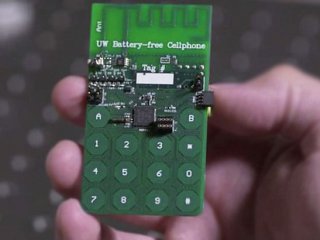New Battery-free Phone makes Calls absorbing energy from the ambience.

A battery-free phone has been developed by University of Washington’s researchers, challenging the issue of dying phones and the requirement of bringing chargers and cables along. The phone absorbs energy from the environment and turns it into power.
The innovative phone requires few micro-watts to work and is capable of harvesting them from either light or ambient radio signals. The researcher also used the prototype to make a call through Skype, demonstrating that the product, made of commercial materials and components, can effectively send and receive speech from a base station.
The new product and the developed technology are described in a paper published in the journal ‘Proceedings of the Association for Computing Machinery on Interactive, Mobile, Wearable and Ubiquitous Technologies’.
“We’ve built what we believe is the first functioning cellphone that consumes almost zero power,” explains Dr Shyam Gollakota, associate professor in the Paul G. Allen School of Computer Science & Engineering at the UW. “To achieve the really, really low power consumption that you need to run a phone by harvesting energy from the environment, we had to fundamentally rethink how these devices are designed.”
The researcher made a significant step toward the solution for one of the biggest issues that modern mobile devices experience: a limited battery that does not allow to enjoy at full the functionality of the modern devices. Designing a product capable of converting analog signals that transmit sound as digital data understandable by phones, operating only through ambient power sources, was a too complicate process, considering that such conversion uses up too much energy.
The new product instead, exploits the vibrations of the phone’s microphone or speaker that happen when people talk or listens in a call. Then, the antenna connected to these parts converts the vibrations in analog radio signals. The process encodes speech patterns in reflected radio signals, limiting the use of power to minimum.
“The cellphone is the device we depend on most today. So if there were one device you’d want to be able to use without batteries, it is the cellphone,” explains Dr Joshua Smith, professor in both the Allen School and UW’s Department of Electrical Engineering. “The proof of concept we’ve developed is exciting today, and we think it could impact everyday devices in the future.”
The researcher created a custom base station to test the device and transmit the radio signals. The technology could be integrated in Wi-Fi routers or standard mobile networks commonly used to make calls.
“You could imagine in the future that all cell towers or Wi-Fi routers could come with our base station technology embedded in it,” said co-author Vamsi Talla, a former UW electrical engineering doctoral student and Allen School research associate. “And if every house has a Wi-Fi router in it, you could get battery-free cellphone coverage everywhere.”
The prototype has a power budget of 3.5 micro-watts and, therefore, it still requires a small amount of energy to do specific operation.
With the power gathered through a solar cell of the size of a grain of rice, the prototype managed to communicate with a 50 feet away base station.
Mostly of the battery-free devices that operate exploiting energy sources, through tools such as accelerometer of temperature sensor, work through intermittent operations, with a sleep stage to save energy and then a use stage of such energy. However, phone calls require devices to work continuously, not allowing rest time, needing a continue intake of energy.
“You can’t say hello and wait for a minute for the phone to go to sleep and harvest enough power to keep transmitting,” explains Bryce Kellogg, one of the authors of the study and a UW electrical engineering doctoral student. “That’s been the biggest challenge – the amount of power you can actually gather from ambient radio or light is on the order of 1 or 10 micro-watts. So real-time phone operations have been really hard to achieve without developing an entirely new approach to transmitting and receiving speech.”
The next aim of the researcher is now to improve the range of transmissions of the prototype, as well as to encrypt the conversation to improve security. The researcher are also working to add a visual display feature, through E-ink screens, and develop a battery-free phone capable of streaming videos.
Written by: Pietro Paolo Frigenti
Journal Reference: Vamsi Talla, Bryce Kellogg, Shyamnath Gollakota, Joshua R. Smith. Battery-Free Cellphone. Proceedings of the ACM on Interactive, Mobile, Wearable and Ubiquitous Technologies, 2017; 1 (2): 1 DOI: 10.1145/3090090
